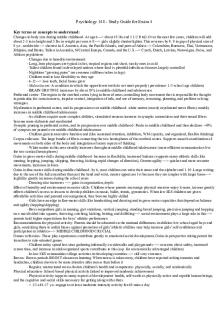Study guide chapter 4 exam 1 PDF

| Title | Study guide chapter 4 exam 1 |
|---|---|
| Author | Raven Dever |
| Course | General Microbiology |
| Institution | University of Kentucky |
| Pages | 8 |
| File Size | 456.3 KB |
| File Type | |
| Total Downloads | 27 |
| Total Views | 135 |
Summary
microbio study guide exam 1 material...
Description
CHAPTER 4 STUDY GUIDE EXAM ONE
Chapter 4: Bacteria and Archaea 1. Compare and contrast the overall size, location of DNA, presence of membrane-bound organelles, ribosomes, cell membrane, and cell wall of prokaryotes and eukaryotes. Human cell is 10x bigger than bacteria, viruses are even smaller than bacteria. Prokaryote: bacteria are prokaryotic NO nucleus around the DNA dna is in the cytoplasm with everything else Cells are way smaller than human cells o But viruses are way smaller than even bacteria Bacteria cells have 70s ribosomes everywhere A 70s targeting drug will affect bacteria AND human cell mitochondria Bacteria have special layers outside the plasma membrane that human cells don’t have Cell wall is ONLY in bacteria Both have cell membrane (layer of lipids) way less DNA circular DNA Eukaryote: human cell and Eukaryotic has nucleus DNA is in center and surrounded by nuclear membrane (fats & lipids protecting the DNA) Cells are way bigger than bacteria Human cell ribosomes are bigger than bacteria ribosomes o drugs can target bacteria without harming human call Human cell ribosomes are 80s except for mitochondria Human cell mitochondria are 70S ribosomes Both have cell membrane (layer of lipids) string DNA: Linear way more DNA Human Cell -Nucleus -80s ribosomes -Mem. Bound organelles -larger -linear DNA -multicellular organism
Both -Cell mem -cytoplasm -70s ribosome for bacteria and 70s mitochondria for human cell
Bacteria -70s ribosomes -cell wall -circular DNA
2. Explain why eukaryotic cells membrane-bound organelles have, while bacterial cells generally do not.
The human cell has sectioned off organelles that help things happen quicker with membrane bound organelles, they are more complex and have a lot more going on so they need the help. 3. Identify the basic shapes and morphologies of bacteria End= Shape Beginning= how they’re arranged Coccus: round bacteria -Diplococci: two bacteria next to each other -Streptococcus: rounded bacteria form a long chain ex: strep throat bacteria -Staphylococci: arranges in clusters, looks like grapes Bacilli: rod shaped -Bacilli: doesn’t have a specific arrangement just rod shaped -Diplobacilli: 2 rod bacilli -Streptobacilli: long chain of rod like connected together 4. State the benefits of having a glycocalyx, flagella, axial filaments, fimbriae, pili, and ability to form endospores for bacteria. Glycocalyx: they are more wider and watery, or tight and a capsule. o Capsules protect from water loss o help bacteria evade immune defenses (phagocytosis) o Prevents phagocyte from attaching to bacteria and destroying it. o Help bacteria form biofilms to protect them against antibiotics and bleach Flagella: helps them move, can use it by chemotaxis o Chemotaxis: bacteria moves in directed way toward a chemical, moves by a tumble-run Axial Filaments: moves like a drill screws through Fimbriae: help bacteria attach and form biofilms Pili: help bacteria attach and form biofilms. Allow bacteria to conjugate or connect. Connection with Pili: bacteria 1 shared DNA with bacteria 2 (like tunnels) Forming Endospores: -Dormant body formed. Have a cortex and multiple layers (endospore coats) certain bacteria can form endospores and shut down during adverse conditions, so they survive past them. o When the conditions pass, they wake back up. o They form when essential nutrients are depleted. o Can survive millions of years without water or food, can survive through heat, toxic chemicals, and radiation.
5. Describe how the cell structure of Gram negative and Gram-positive cells lead to a given Gram stain result. Gram Positive: thick cell wall, thick layer of peptidoglycan, 1 plasma membrane, has teichoic acid
Gram Negative: thin peptidoglycan layer, inner membrane layer, two plasma membranes, Lipopolysaccharide (LPS), periplasmic space *1. Crystal violet added to both cells. Both are purple 2. Gram’s Iodine is added; thicker peptidoglycan cell wall can hold it and trap the large complexes (gram positive traps dye complex in thick wall) unlike the thin gram-negative cells. (no effect of iodine in gram negative) 3.Alcohol is applied and dissolves lipids in outer membrane and removes purple dye from peptidoglycan layer in gram negative cells. 4. Safranin (red dye): since gram negative is colorless after decolorization, this is shown by adding the counterstain safranin in the final step. Gram positive= purple -iodine stays in gram positive bec the peptidoglycan layer is so thick Gram negative= pink -iodine washes out of thin peptidoglycan layer takes up the safranin and turns pink
6. Define the function of the main components of the bacterial cell. Bacterial Chromosome or nucleoid: composed of condensed DNA molecules. DNA directs all genetics and heredity of the cell and codes for all proteins. Ribosomes: tiny particles composed of protein and RNA that are sites of protein synthesis Cytoplasm: water-based solution filling the entire cell Fimbriae: fine, hair like bristles extending from the cell surface that help in adhesion to to other cells and surfaces. Cell wall: a semirigid casing that provides structural support and shape for the cell Actin Cytoskeleton: long fibers of proteins that encirclw the cell just inside the cytoplasmic membrane and contribute to the shape of the cell. Pili: an appendage used for drawing another bacterium close in order to transfer DNA to it.
Capsule: A coating or layer of molecules external to the cell wall. It serves protective adhesive and receptor functions. It may fit tightly or be loose and diffuse. Also called slime layer and glycocalyx. Define these terms: Motility:
Chemotaxis:
Conjugation:
Biofilm:
Peptidoglycan:
Key Figures: 4.1
Insight 4.1
4.3 Bacterial shapes and arrangements
4.16 Comparison of gramnegative and gram-positive cell envelopes
4.17
Insight 4.2
4.24
Draw this: Diplococci
Streptococci
Staphylococci
Diplobacillus
Streptobacillus
staphylobacillus bacteria
The cell wall of a gram-negative bacteria (label peptidoglycan, plasma membrane, lipopolysaccharide, and periplasm) and gram-positive bacteria (label peptidoglycan, teichoic acid, and plasma membrane)
Suggested study questions (from the textbook at the end of the chapter): Multiple Choice and True-False Questions: 2, 3, 4, 5, 7, 11, 14, 15...
Similar Free PDFs

Study guide chapter 4 exam 1
- 8 Pages

Exam 4 Study Guide
- 22 Pages

EXAM 4 study guide
- 15 Pages

Study Guide Exam 4
- 8 Pages

Exam 4 Study Guide
- 4 Pages

Study guide exam 4
- 6 Pages

Exam 4 Study Guide
- 5 Pages

Exam 1 Study Guide Chapters 1-4
- 2 Pages

Exam 1 (Ch.1-4) Study Guide
- 3 Pages

Chapter 4 Study Guide
- 4 Pages

Chapter 4 Study Guide
- 11 Pages

MGMT exam 4 - Study Guide exam 4
- 12 Pages

Chapter 4 Study Guide
- 9 Pages

Chapter-4 study guide
- 45 Pages

Chapter 4 Study Guide
- 9 Pages
Popular Institutions
- Tinajero National High School - Annex
- Politeknik Caltex Riau
- Yokohama City University
- SGT University
- University of Al-Qadisiyah
- Divine Word College of Vigan
- Techniek College Rotterdam
- Universidade de Santiago
- Universiti Teknologi MARA Cawangan Johor Kampus Pasir Gudang
- Poltekkes Kemenkes Yogyakarta
- Baguio City National High School
- Colegio san marcos
- preparatoria uno
- Centro de Bachillerato Tecnológico Industrial y de Servicios No. 107
- Dalian Maritime University
- Quang Trung Secondary School
- Colegio Tecnológico en Informática
- Corporación Regional de Educación Superior
- Grupo CEDVA
- Dar Al Uloom University
- Centro de Estudios Preuniversitarios de la Universidad Nacional de Ingeniería
- 上智大学
- Aakash International School, Nuna Majara
- San Felipe Neri Catholic School
- Kang Chiao International School - New Taipei City
- Misamis Occidental National High School
- Institución Educativa Escuela Normal Juan Ladrilleros
- Kolehiyo ng Pantukan
- Batanes State College
- Instituto Continental
- Sekolah Menengah Kejuruan Kesehatan Kaltara (Tarakan)
- Colegio de La Inmaculada Concepcion - Cebu
